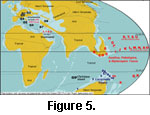CLIMATE AND THE POSITION OF MAJOR PLATES IN
EOCENE TIMES
A wide range of data, most directly oxygen isotopic measurements
(Pearson et al 2001) indicate that in the Eocene the global climate was warmer than it is now. From this data we can extrapolate that what we now consider "tropical" faunas would have occupied a wider latitudinal zone (the astronomically defined Tropics of Cancer and Capricorn being unchanged). Therefore warm water, photic foraminifera with larger tests would probably have been major rock- forming organisms at higher latitudes than they were in later Tertiary or modern times.
 In the Eocene, the northern edge of the Australian plate would have been around 2,000 kms to 2,800 km further south of its current location, based on 5 to 7 cm of drift per year over 40 Ma
(Le Pichon 1968, Veevers et al.
1991) (Fig. 5). Under the prevailing warm Eocene climate even this southerly location was obviously quite capable of supporting highly active biohermal organisms, and many hundreds of feet of carbonate rocks were deposited over a huge shelf area.
In the Eocene, the northern edge of the Australian plate would have been around 2,000 kms to 2,800 km further south of its current location, based on 5 to 7 cm of drift per year over 40 Ma
(Le Pichon 1968, Veevers et al.
1991) (Fig. 5). Under the prevailing warm Eocene climate even this southerly location was obviously quite capable of supporting highly active biohermal organisms, and many hundreds of feet of carbonate rocks were deposited over a huge shelf area.
The records of Eocene carbonate faunas from the widely spaced Pacific islands show that the APB genera were able to migrate over large distances of open ocean (This also applies to the associated genera
Nummulites, Discocyclina, and others.). Therefore, there is no reason to think there were any significant migration barriers to cause the differentiation of the APB and
Lacazinella faunas. There is still no data indicating that Lacazinella was able to migrate over oceanic distances, although reports of this genus from the Late Paleocene of the Middle East
(White 1994) might have impact on this subject. It is possible that the APB-Lacazinella faunal differentiation was an effect related to the difference in latitude in Eocene times, such as a variation in light intensityor tolerance of seasonality. Seasonal variation is an environmental factor that greatly increases outside the true geographic tropics and is therefore not a condition seen as clearly in younger Tertiary or modern biohermal carbonate facies that are restricted to the true tropics. It is therefore possible that
Lacazinella was adapted to warm water conditions but also a summer-winter (solstice to solstice) cycle, and it may have been this, or a related factor, that kept the APB fauna from establishing itself in the south. More work on the northern Indo-Pacific distribution of APB faunas would shed some light on this hypothesis, if enough Eocene carbonates can be found and studied.

 In the Eocene, the northern edge of the Australian plate would have been around 2,000 kms to 2,800 km further south of its current location, based on 5 to 7 cm of drift per year over 40 Ma
(Le Pichon 1968, Veevers et al.
1991) (Fig. 5). Under the prevailing warm Eocene climate even this southerly location was obviously quite capable of supporting highly active biohermal organisms, and many hundreds of feet of carbonate rocks were deposited over a huge shelf area.
In the Eocene, the northern edge of the Australian plate would have been around 2,000 kms to 2,800 km further south of its current location, based on 5 to 7 cm of drift per year over 40 Ma
(Le Pichon 1968, Veevers et al.
1991) (Fig. 5). Under the prevailing warm Eocene climate even this southerly location was obviously quite capable of supporting highly active biohermal organisms, and many hundreds of feet of carbonate rocks were deposited over a huge shelf area.